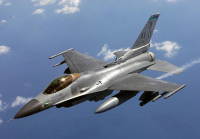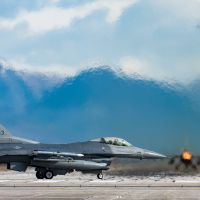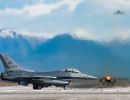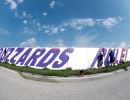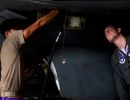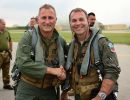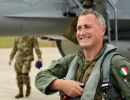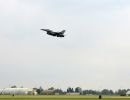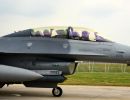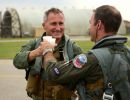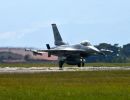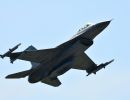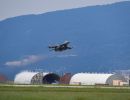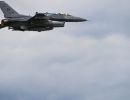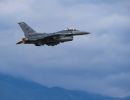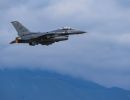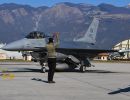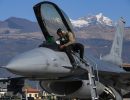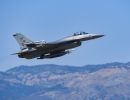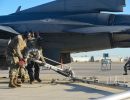In an air combat role, the F-16's maneuverability and combat radius (distance it can fly to enter air combat, stay, fight and return) exceed that of all potential threat fighter aircraft. It can locate targets in all weather conditions and detect low flying aircraft in radar ground clutter. In an air-to-surface role, the F-16 can fly more than 500 miles (860 kilometers), deliver its weapons with superior accuracy, defend itself against enemy aircraft, and return to its starting point. An all-weather capability allows it to accurately deliver ordnance during non-visual bombing conditions.
The F-16 was built under an unusual agreement creating a consortium between the United States and four NATO countries: Belgium, Denmark, the Netherlands and Norway. These countries jointly produced with the United States an initial 348 F-16s for their air forces. Final airframe assembly lines were located in Belgium and the Netherlands. The consortium's F-16s are assembled from components manufactured in all five countries. Belgium also provides final assembly of the F100 engine used in the European F-16s. The long-term benefits of this program will be technology transfer among the nations producing the F-16, and a common-use aircraft for NATO nations. This program increases the supply and availability of repair parts in Europe and improves the F-16's combat readiness.
USAF F-16 multi-mission fighters were deployed to the Persian Gulf in 1991 in support of Operation Desert Storm, where more sorties were flown than with any other aircraft. These fighters were used to attack airfields, military production facilities, Scud missiles sites and a variety of other targets.
Originally conceived as a simple air-superiority day fighter, the aircraft was armed for that mission with a single six-barrel Vulcan 20-mm cannon and two Sidewinder missiles, one mounted at each wingtip. Over the years, however, the mission capability of the aircraft has been extended to include ground-attack and all-weather operations With full internal fuel, the aircraft can carry up to 12 000 pounds of external stores including various types of ordnance as well as fuel tanks.
The original F-16 was designed as a lightweight air-to-air day fighter. Air-to-ground responsibilities transformed the first production F-16s into multirole fighters. The empty weight of the Block 10 F-16A is 15,600 pounds. The empty weight of the Block 50 is 19,200 pounds. The A in F-16A refers to a Block 1 through 20 single-seat aircraft. The B in F-16B refers to the two-seat version. The letters C and D were substituted for A and B, respectively, beginning with Block 25. Block is an important term in tracing the F-16's evolution. Basically, a block is a numerical milestone.The block number increases whenever a new production configuration for the F-16 is established. Not all F-16s within a given block are the same. They fall into a number of block subsets called miniblocks. These sub-block sets are denoted by capital letters following the block number (Block 15S, for example). From Block 30/32 on, a major block designation ending in 0 signifies a General Electric engine; one ending in 2 signifies a Pratt & Whitney engine.
General characteristics:
* Crew: 1
* Length: 49 ft 5 in (14.8 m)
* Wingspan: 32 ft 8 in (9.8 m)
* Height: 16 ft (4.8 m)
* Wing area: 300 ft² (27.87 m²)
* Airfoil: NACA 64A204 root and tip
* Empty weight: 18,238 lb (8,272 kg)
* Loaded weight: 26,463 lb (12,003 kg)
* Max takeoff weight: 42,300 lb (16,875 kg)
* Powerplant: 1× Pratt & Whitney F100-PW-220 afterburning turbofan
o Dry thrust: 14,590 lbf (64.9 kN)
o Thrust with afterburner: 23,770 lbf (105.7 kN)
* Alternate powerplant: 1× General Electric F110-GE-100 afterburning turbofan
o Dry thrust: 17,155 lbf (76.3 kN)
o Thrust with afterburner: 28,985 lbf (128.9 kN)
Performance
* Maximum speed:
o At sea level: Mach 1.2 (915 mph, 1,460 km/h)
o At altitude: Mach 2+ (1,500 mph, 2,414 km/h) at altitude
* Combat radius: 340 mi (295 nm, 550 km) on a hi-lo-hi mission with six 1,000 lb (450 kg) bombs
* Ferry range: >3,200 mi (2,800 nm, 4,800 km)
* Service ceiling: >50,000 ft (15,239 m)
* Rate of climb: 50,000 ft/min (254 m/s)
* Wing loading: 88.2 lb/ft² (431 kg/m²)
* Thrust/weight: For F100 engine: 0.898, For F110: 1.095
Armament
* Guns: 1× 20 mm (0.787 in) M61 Vulcan gatling gun, 511 rounds
* Rockets: 2¾ in (70 mm) CRV7
* Missiles:
o Air-to-air missiles:
+ 6× AIM-7 Sparrow or
+ 6× AIM-9 Sidewinder or
+ 6× AIM-120 AMRAAM or
+ 6× Python-4
o Air-to-ground missiles:
+ 6× AGM-45 Shrike or
+ 6× AGM-65 Maverick or
+ 6× AGM-88 HARM
o Anti-ship missiles:
+ 4× AGM-84 Harpoon or
+ 4× AGM-119 Penguin
* Bombs:
o 2× CBU-87 Combined Effects Munition
o 2× CBU-89 Gator mine
o 2× CBU-97 Sensor Fuzed Weapon
o Wind Corrected Munitions Dispenser capable
o 4× GBU-10 Paveway
o 6× GBU-12 Paveway II
o 6× Paveway-series laser-guided bombs
o 4× JDAM
o 4× Mk 80 series
o B61 nuclear bomb

